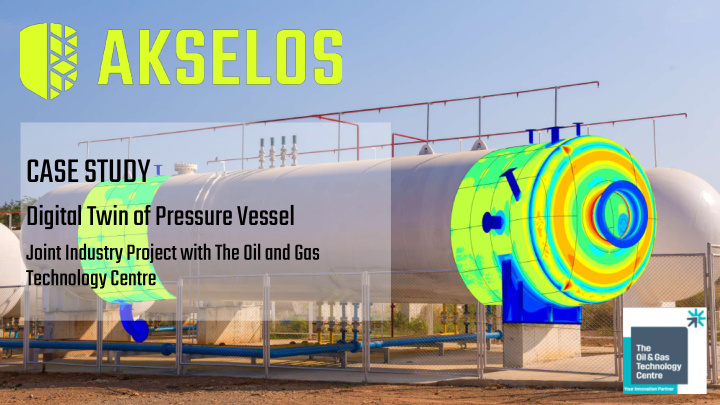



CASE STUDY Digital Twin of Pressure Vessel Joint Industry Project with The Oil and Gas Technology Centre
45% PROJECT DRIVERS REDUCTION IN EQUIPMENT IMPROVE INDUSTRY PRACTICE FOR INSPECTION AND • DOWNTIME MAINTANANCE OF PRESSURE VESSELS UNLOCK THE FULL POTENTIAL OF OGTC’S ROBOTIC • INSPECTION INCREASE ACCURACY/SPEED AND REDUCE • 25% COST/CONSERVATISM OF ASSESSMENT PRODUCE HIGHLY PREDICTIVE FRAMEWORK - FREQUENT • AUTOMATED INSPECTIONS – DETAILED COMPUTATIONAL ANALYSIS MAINTENANCE COST THROUGH A PHYSICS-BASED INTERPRETATION OF • INSPECTION DATA. FACILITATED BY AKSELOS STRUCTURAL DIGITAL TWIN REDUCTION • TECHNOLOGY
AKSELOS TIES IN PERFECTLY WITH THE FOCUS ON ROBOTICS AND AUTOMATION, HARNESSING THE POWER OF DATA AND TECHNOLOGY TO IMPROVE OVERALL ASSET EFFICIENCY.
PRESSURE VESSELS STRUCTURAL DIGITAL TWINS NEXT GENERATION SIMULATION TECHNOLOGY • 1000x faster than traditional technology • Parametric • Cloud STRUCTURAL DIGITAL TWIN • Detailed and Physics Based replica of a Physical Asset • Sensor connected to reflect real world loading and condition • Continual prediction of structural integrity CAPABILITIES • Guide optimization of Inspection, Maintenance & Repair processes • Operational Scenario Planning Support • Life extension studies
PRESSURE VESSELS DIGITAL TWIN CALCULATIONS BASED SINGLE DIGITAL FITNESS FOR NEW INCREASED ON HIGH FIDELITY, THREAD FORM SERVICE SIMULATION STRUCTURAL DIGITAL ACCURACY INSPECTION TO ASSESSMENT TECHNOLOGY TWIN CALCULATION CONSISTENT PROCESS AUTOMATED ROBOTIC INSPECTION BASED ON SIMULATION INCREASED SPEED DATA FLOW AND THROUGH TO (SKIP L1 AND L2 PROCESS STRUCTURAL ANALYSIS ASSESSMENT) PHYSICS BASED APPROACH INSPECTION AND COST EFFICIENT USING STRUCTURAL REPAIR PLANNING DIGITAL TWIN API 579 STANDARDS BASED ASSESSMENT
CASE STUDY: JOINT INDUSTRY PROJECT SCOPE • Produce more accurate predictions for maintenance and inspection - including where and when repairs will be needed. • Simulate robotics inspection data and flows, to enable accurate validation of the structural integrity (FFS - Fitness For Service), • Deliver frameworks for a cost-efficient inspection and repair planning based on Digital Twin. • Akselos to demonstrate a new workflow within the API 579 standard that will be much faster than conventional methods
CASE STUDY: AKSELOS PROVIDES SUPPORT FOR FAST UPLOAD OF INSPECTION DATA Workflows are accelerated by Akselos with many steps automated
CASE STUDY: AKSELOS SUPPORTS A LEVEL 3 ASSESSMENT OF PRESSURE VESSELS IN AN OPERATIONAL CONTEXT • Most detailed evaluation that provides more precise results (within the required API 579 standard) • Evaluation equipment for plastic collapse, local failure, collapse from buckling and failure from cyclic loading Assessments General Metal Loss Local Metal Loss Elastic Analysis Elastic Analysis Elastic-plastic Analysis Elastic-plastic Analysis
DIGITAL TWIN FOR PRESSURE VESSELS (a) (b) (c) Data inputs Shell component 2D UV mapping Scan plan (d) (e) (f) Thicknesses mapped to Automated re-analysis Thickness profile Digital Twin and reporting
DIGITAL TWIN IMPLEMENTATION REPORT 1X AUTOMATICALLY Digital Twin model creation for Fitness-For-Service evaluations based on Full digital thread scenario and Pressure Vessel API-579/ASME FFS-1 [1] automation REPEATED
Automate Level 1 & Level 2 Assessments of General Metal Loss
CASE STUDY: PRESSURE VESSEL AKSELOS ANALYSIS
AUTOMATE LEVEL 1 ASSESSMENTS OF LOCAL METAL LOSS (2/4) Ignoring areas which are smaller than 50mm 2 (7mm x 7mm) • Marked Local Thin C-scan Data Areas (LTAs) and Grooves (larger than 50 mm 2 ) Extracted Thickness Profile of LTAs and Grooves
AUTOMATE LEVEL 2 ASSESSMENT OF GENERAL METAL LOSS Automatically recognize flaws for an assessment • Ignoring flaws with area smaller than 500mm 2 (23mm x 23mm) • Color Coded C-scan Data Continuous Corrosion Areas (Flaws) (larger than 500 mm 2 ) Extracted #61 Thickness Profile of Flaws #37 #49
LEVEL 3 ASSESSMENT – EXAMPLE Protection against Plastic Collapse and Local Failure using Elastic Analysis Method Elasticity results of the “as-is” (updated thickness) model Internal Pressure: 13BAR Internal Pressure: 19BAR
LEVEL 3 ASSESSMENT – IDENTIFICATION OF CRITICAL AREAS Stress Classification Lines (SCLs) at Critical Locations are identifying manually
LEVEL 3 ASSESSMENT EXAMPLES Stress Classification Lines (SCLs) at Local Thin Areas are identifying manually
CASE STUDY: PRESSURE VESSEL AKSELOS ANALYSIS
DIGITAL TWIN FOR PRESSURE VESSELS (a) (b) (c) Pristine Model Shell component 2D UV mapping Scan plan (d) (e) (f) Thicknesses mapped to Automated re-analysis Thickness profile Digital Twin and reporting
PRESSURE VESSEL DIGITAL TWIN: SUMMARY Akselos has demonstrated a new workflow within the API • 579 standard that will be much faster than conventional workflows. WATCH NOW Produce more accurate predictions for maintenance and • inspection - including where and when repairs will be needed. Integrate robotic inspection data and flows, to enable • accurate validation of the structural integrity (FFS - Fitness For Service assessment into operations), Deliver frameworks for a cost-efficient inspection and repair • planning based on Digital Twin. Industry Research estimate that these improvements with be • a game changer for Inspection planning saving over £140 million across the UK sector alone. READ MORE
Recommend
More recommend